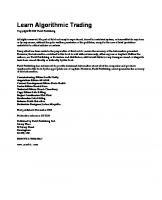Super Stock Trading Pro: Algorithmic Trading with Python
Reactive Publishing Unlock the Power of Python in Stock Trading: Become a Super Stock Trading Pro! Dive into the dynami
191 55
English Pages 1170 Year 2024
Table of contents :
Title Page
Contents
Chapter 1: Introduction to Algorithmic Trading
1.1 Definition of Algorithmic Trading
1.2 Key Benefits of Algorithmic Trading
1.3 Fundamentals of Algorithm Design
1.4 Regulatory and Ethical Considerations
Chapter 2: Understanding Financial Markets
2.1 Market Structure and Microstructure
2.2 Asset Classes and Instruments
2.3 Fundamental and Technical Analysis
2.4 Trading Economics
Chapter 3: Python for Finance
3.1 Basics of Python Programming
3.2 Data Handling and Manipulation
3.3 API Integration for Market Data
3.4 Performance and Scalability
Chapter 4: Quantitative Analysis and Modeling
4.1 Statistical Foundations
4.2 Portfolio Theory
4.3 Value at Risk (VaR)
4.4 Algorithm Evaluation Metrics
Chapter 5: Strategy Identification and Hypothesis
5.1 Identifying Market Opportunities
5.2 Strategy Hypothesis Formulation
5.3 Data Requirements and Sources
5.4 Tools for Strategy Development
Chapter 6: Building and Backtesting Strategies
6.1 Strategy Coding in Python
6.2 Backtesting Frameworks
6.3 Performance Analysis
6.4 Optimization Techniques
Chapter 7: Advanced Trading Strategies
7.1 Machine Learning for Predictive Modeling
7.2 High-Frequency Trading Algorithms
7.3 Sentiment Analysis Strategies
7.4 Multi-Asset and Cross-Asset Trading
Chapter 8: Real-Time Back testing and Paper Trading
8.1 Simulating Live Market Conditions
8.2 Refinement and Iteration
8.3 Robustness and Stability
8.4 Compliance and Reporting in Algorithmic Trading
Chapter 9: Machine Learning and AI
9.1 Deep Learning and Neural Networks
9.2 Reinforcement Learning for Trading
9.3 Natural Language Processing (NLP)
9.4 NLP Integration in Market Prediction Models
Chapter 10 : Blockchain and Cryptocurrency Markets
10.1 Fundamentals of Blockchain Technology
10.2 Trading Cryptocurrencies
10.3 Tokenization and Asset Representation
10.4 Decentralized Finance (DeFi)
Chapter 11: Quantum Computing in Finance
11.1 Quantum Computing Fundamentals
11.2 Quantum Algorithms for Optimization
11.3 Quantum Computing for Risk Analysis
11.4 Future Prospects of Quantum Computing in Trading
Chapter 12: Setting Up a Trading Environment
12.1 Hardware and Software Requirements
12.2 Platform and Broker Selection
12.3 Security and Encryption
12.4 Development and Testing Environments
Chapter 13: Execution Systems
13.1 Order Management Systems (OMS)
13.2- Direct Market Access (DMA) in Algorithmic Trading
13.3 Execution Algorithms
13.4 Transaction Cost Analysis (TCA)
Chapter 14: Real-Time Data Processing
14.1 Streaming Data and Tick Processing
14.2 Market Data Feeds
14.3 Event-Driven Architectures
14.3 Monitoring and Alerting
Chapter 15: Risk and Compliance Management
15.1 Real-Time Risk Assessment
15.2 Algorithmic Trading Regulations
15.3 Compliance and Controls
15.4 Business Continuity Planning
Epilogue
Additional Resources
Title Page
Contents
Chapter 1: Introduction to Algorithmic Trading
1.1 Definition of Algorithmic Trading
1.2 Key Benefits of Algorithmic Trading
1.3 Fundamentals of Algorithm Design
1.4 Regulatory and Ethical Considerations
Chapter 2: Understanding Financial Markets
2.1 Market Structure and Microstructure
2.2 Asset Classes and Instruments
2.3 Fundamental and Technical Analysis
2.4 Trading Economics
Chapter 3: Python for Finance
3.1 Basics of Python Programming
3.2 Data Handling and Manipulation
3.3 API Integration for Market Data
3.4 Performance and Scalability
Chapter 4: Quantitative Analysis and Modeling
4.1 Statistical Foundations
4.2 Portfolio Theory
4.3 Value at Risk (VaR)
4.4 Algorithm Evaluation Metrics
Chapter 5: Strategy Identification and Hypothesis
5.1 Identifying Market Opportunities
5.2 Strategy Hypothesis Formulation
5.3 Data Requirements and Sources
5.4 Tools for Strategy Development
Chapter 6: Building and Backtesting Strategies
6.1 Strategy Coding in Python
6.2 Backtesting Frameworks
6.3 Performance Analysis
6.4 Optimization Techniques
Chapter 7: Advanced Trading Strategies
7.1 Machine Learning for Predictive Modeling
7.2 High-Frequency Trading Algorithms
7.3 Sentiment Analysis Strategies
7.4 Multi-Asset and Cross-Asset Trading
Chapter 8: Real-Time Back testing and Paper Trading
8.1 Simulating Live Market Conditions
8.2 Refinement and Iteration
8.3 Robustness and Stability
8.4 Compliance and Reporting in Algorithmic Trading
Chapter 9: Machine Learning and AI
9.1 Deep Learning and Neural Networks
9.2 Reinforcement Learning for Trading
9.3 Natural Language Processing (NLP)
9.4 NLP Integration in Market Prediction Models
Chapter 10 : Blockchain and Cryptocurrency Markets
10.1 Fundamentals of Blockchain Technology
10.2 Trading Cryptocurrencies
10.3 Tokenization and Asset Representation
10.4 Decentralized Finance (DeFi)
Chapter 11: Quantum Computing in Finance
11.1 Quantum Computing Fundamentals
11.2 Quantum Algorithms for Optimization
11.3 Quantum Computing for Risk Analysis
11.4 Future Prospects of Quantum Computing in Trading
Chapter 12: Setting Up a Trading Environment
12.1 Hardware and Software Requirements
12.2 Platform and Broker Selection
12.3 Security and Encryption
12.4 Development and Testing Environments
Chapter 13: Execution Systems
13.1 Order Management Systems (OMS)
13.2- Direct Market Access (DMA) in Algorithmic Trading
13.3 Execution Algorithms
13.4 Transaction Cost Analysis (TCA)
Chapter 14: Real-Time Data Processing
14.1 Streaming Data and Tick Processing
14.2 Market Data Feeds
14.3 Event-Driven Architectures
14.3 Monitoring and Alerting
Chapter 15: Risk and Compliance Management
15.1 Real-Time Risk Assessment
15.2 Algorithmic Trading Regulations
15.3 Compliance and Controls
15.4 Business Continuity Planning
Epilogue
Additional Resources

- Author / Uploaded
- Hayden Van Der Post
- Similar Topics
- Computers
- Software: Systems: scientific computing









